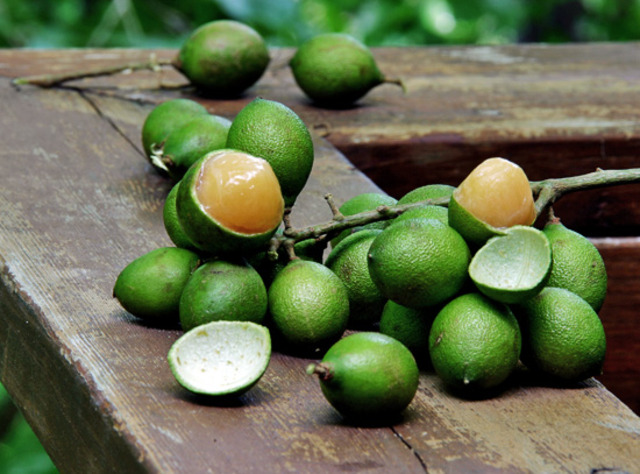Whether you see the mango’s hanging in the trees or the fresh fruit cocktail on the side table of your pool bed, the link is there: you are in the tropics. Aruba grows her own fruits and veggies and there are some pretty out-of-space local species you may never had heard of, but really healthy and delicious.
Kenepa
Ovoid green fruit that grows in bunches on trees up to 30m high. The fruit is related to the lychee and have tight, thin but rigid skins. Inside the skin is the tart, tangy, or sweet pulp of the fruit covering a large seed. The pulp is usually cream or orange colored. Kenepa strengthens the immune system, and prevents the reproduction of bacteria and viruses in the body. This fruit is highly recommended to treat lung infections and urinary tract infections. It also helps to cure insomnia and rejuvenates the nervous system. Season: the fruit typically ripen during the summer.
Druif
There is no chance you did not bump into one of the sea grape trees while spending your vacation on Aruba. The sea grape plant is often used in ocean-side landscaping in sandy soil right on the beach and it produces clusters of fruit that resemble grapes. Are sea grapes edible? Yes, they are. Animals enjoy sea grapes and humans can eat them as well, and they are used to make jam. They contain very low calories and sugar, enabling good bacterium to digest food and excrete waste quickly which is effective in preventing constipation. Season: Sep-Oct.
Shimaruku
Maybe Aruba’s most popular wild fruit tree. You may have noticed cars at the side of the road and people picking those red berries. Well, that’s Shimaruku. The local habit to stop for these delicious fruits goes from generation to generation. Its fruit’s degree of sour depends on the amount of rain it gets. Red Shimarukus tend to taste better than orange. The fruit has super power: a true vitamin bomb. Adults only need to eat 3-4 of these berries to meet their daily recommended amount of Vitamin C. Season: Rainy months (Oct-Jan).
Tamarind
A delicious, sweet fruit that has a wide variety of uses and applications, both for medicinal and culinary purposes. It is a medium-sized bushy tree with evergreen leaves and fruit that develops in pods characterized by long, brown shells. Inside is a sticky, fleshy, juicy pulp, which is the Tamarind fruit. Both sweet and sour in taste, the fruit contains a significant level of vitamin C, as well as vitamin E, B vitamins, calcium, iron, phosphorous, potassium, manganese, and dietary fiber. There are also a number of organic compounds that make tamarind a powerful antioxidant and anti-inflammatory agent. Season: March.

















